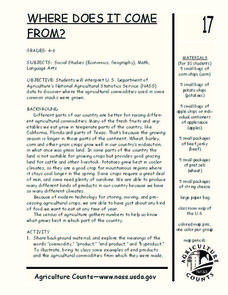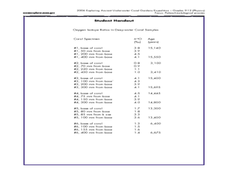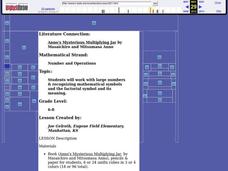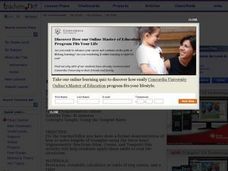Curated OER
Rectilinear Motion
Twelfth graders rewrite word problems using algebraic expressions. In this calculus lesson, 12th graders calculate the velocity, time and acceleration while analyzing real life scenarios. They solve problems related to when the...
Curated OER
Quilt Squared
Students study West Virginia quilts. For this mathematics lesson, students use symmetry, geometric shapes, and patterns to create their own quilt square.
Curated OER
How much is Dirt Worth?
Learners problem solve to understand the value of the Earth's soil. In this value of dirt instructional activity, students understand how much of Earth is made of dirt and how important to our survival it is.
Curated OER
Where Does It Come from?
Learners read articles about various agricultural products and create a map using the statistics in the article. In this agricultural statistics lesson, students look at the geography of the country and which products come from the...
Curated OER
Surfing Amusement parks
Students must surf the Internet to find out how much it cost for his or her family to go to amusement parks in California.
Curated OER
The Five Senses - Barefoot Walking Trip
Students go outside and take a little barefoot walking trip. They talk to each other about their experiences on the trip to help them remember everything they can. They go on a walk for at least 15 minutes. Ask questions during the trip.
Curated OER
Telling Time in Different Time Zone
Fourth graders create clocks and complete small group activities to represent the six different times zones in the US. Using small paper plate clocks, 4th graders visually demonstrate the differences in these time zones.
Curated OER
How Many Stars in the Milky Way?
Students perform an experiment in which they will use a statistical method called `sampling' to count to a billion (and beyond). Students practice sampling by estimating the number of characters on a page from the classified section of a...
Curated OER
Let's Go To Mexico
Students are able to use the Internet to conduct research. They research Mexican culture and traditions. Students compare and contrast Mexican and U.S. food and clothing. They convert United States currency to Mexican pesos. Students...
Curated OER
Air Pressure & Barometers
Fourth graders observe, measure, and record data on the basic elements of weather over a period of time (i.e., precipitation, air temperature, wind speed and direction, and air pressure). Then, they make a barometer and keep record of...
Curated OER
Look At Those Leaves!
Young scholars observe and sort tree leaves. In this earth science lesson, students observe the attributes of real leaves and measure leaves using Unifix cubes.
Curated OER
Wolves
Learners explore wolves. In this ecology and wolves lesson, students research predator-prey relationships on the Internet and complete a related worksheet with a partner. Learners interpret data on bar graphs to determine growth and...
Curated OER
Zoom Out
Students explore visual perception and how objects change as distance changes. In this distance and vision lesson, students practice their scientific inquiry skills. Students practice drawing objects from different points of view in...
Curated OER
How can deep-water corals be used to determine long-term patterns of climate change?
Students explore the concept of paleoclimatological proxies. In this paleoclimatological proxies lesson, students explain isotope ratios in deep water coral samples. Students write a paragraph about global climate change as it effects...
Curated OER
Graphin' and Glyphin' Utah Weather
Fourth graders use glyphs as a way to visually represent information about Utah weather. These nonverbal representations help students collect and interpret data in a visual format.
Curated OER
"Anno's Mysterious Multiplying Jar" by Masaichiro and Mitsumasa Anno
Learners work with large numbers and recognizing mathematical symbols and the factorial symbol and its meaning.
Curated OER
Time Zones in the United States
Eighth graders explore how to use the time zones in the United States and internationally. They use elapsed time to solve problems. Students calculate the time in various places in the United States. They discuss the 6 time zones in the...
Curated OER
Slippery Slope
Students define patterns, relation and function. In this algebra lesson plan, students find the slope of a line and write equations of line. They model the slope using real life scenarios.
Curated OER
Make Your Own "Weather" Map
Students develop and apply a variety of strategies to solve problems, with an emphasis on multi-step and non-routine problems. They acquire confidence in using mathematics meaningfully.
Curated OER
Two-Step Equations
Sixth graders work through a two-step equation with their teacher. After reviewing one-step equations, they complete a worksheet using tiles and colored pencils to complete two-step equations. To end the lesson, they write out the step...
Curated OER
Two Step Equations
Sixth graders solve multiple step math problems. In this problem solving lesson plan, 6th graders practice following step by step instructions such as making cookies or building a snowman. Students use algebra tiles and draw pictures to...
Curated OER
Calculating Distance On Maps
Fourth graders determine the mileage from the local community to various scenic attractions in the Four-Corners-Region. They receive direct instruction and carry out activities in cooperative group settings.
Curated OER
Intro to Trigonometry
After being introduced to the basic trigonometry functions, students calculate the height of school landmarks. They experiment with different angles to find the correct height.
Curated OER
Does Santa Claus use the Coriolis Force to Travel East?
Students are given a visual demonstration of the Coriolis Force in the Northern Hemisphere. They are encouraged to find locations around the globe and try to predict what the weather circulation patterns might be like.

























